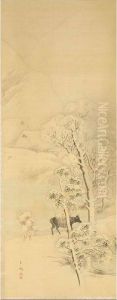Hasegawa Gyokuho Paintings
Hasegawa Gyokuho was a Japanese artist born in 1809, during the late Edo period, a time characterized by the ruling Tokugawa shogunate's efforts to isolate Japan from foreign influences. This period, however, was also marked by a rich cultural growth internally, especially in the arts, including painting, printmaking, and literature. Gyokuho was part of this vibrant artistic tradition, contributing significantly to the world of Japanese painting.
Gyokuho was primarily known for his work in the Nanga or Bunjinga style of painting. This style was deeply influenced by Chinese literati painting, focusing on scholarly and poetic themes and incorporating calligraphy into the artwork. It was a style that celebrated the natural world, with an emphasis on landscapes, flowers, and birds, and it appealed to the intellectual and cultural elite of Japan. Gyokuho, like many artists of the Nanga school, was adept at integrating the philosophical underpinnings of Confucianism, Taoism, and Zen Buddhism into his work, which added layers of meaning to his paintings.
Throughout his relatively short life—Gyokuho died in 1852 at the age of 43—his contribution to the Nanga movement was significant. His works were celebrated for their delicate brushwork, subtle use of color, and the profound sense of tranquility they evoked. Gyokuho's paintings often reflected a deep appreciation of the natural landscape, embodying the Japanese aesthetic principle of wabi-sabi, which finds beauty in simplicity, impermanence, and imperfection. His art was not just a visual experience but also an invitation to contemplation, encouraging the viewer to engage with the natural world and the larger philosophical questions it posed.
Despite his contributions to the Nanga movement and Japanese art, Gyokuho's work is not as widely recognized internationally as some of his contemporaries. However, within Japan and among scholars of Japanese art, his paintings are admired for their beauty and depth. Today, his works can be found in collections of Japanese art around the world, serving as a testament to the enduring appeal of the Nanga style and Gyokuho's mastery of it. His legacy lives on, not only in his own artworks but also in the influence he had on subsequent generations of Japanese artists who continued to explore and evolve the Nanga aesthetic.
